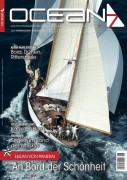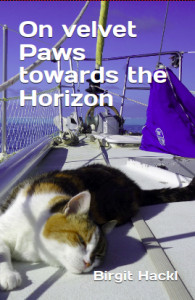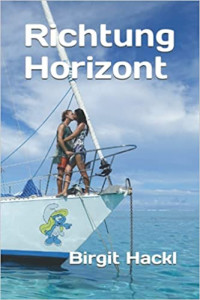We’ve finally got a date for the canal transit: Saturday, 15.12.12. We’ll spend the rest of the week in Colon, doing shopping and getting the boat ready for our linehandlers. At the moment fitting 3 overnight guests into Pitufa seems quite a challenge, the forecabin’s stuffed with all kinds of things up the ceiling, but we’ll find space for all the stuff somewhere ![]()
2012
12
Dec
Transit on Saturday!!
2012
12
Dec
Measured and almost ready for the canal!
Of course the preparations for the canal transit work out “Panamanian”–meaning not exactly smoothly. We sailed to Colon on Sunday for our appointment with the admeasurer at 8 on Monday. We waited all Monday morning, at 1 o’clock finally a pilot boat approached us with an admeasurer on board, but he didn’t have our papers with him (only our neighbours) and we were told to wait for the next day. Today at 10 the admeasurer finally came, measured Pitufa from anchor to windsteering (it’s a farce as all boats under 50 feet pay the same price) and gave us some papers. With these papers we went to a special branch of the bank and paid the Canal fee: 1.875 US dollars to be paid in cash, 891 of them are a deposit in case Pitufa damages the canal (maybe the concrete walls??) while we had to sign a form relieving the canal authorities of all liablity in case the canal does damage to Pitufa ![]() We were told to call the scheduler’s office after 6 in the evening, but our paper’s hadn’t arrived at the office and they put us off until tomorrow (as was to be expected).
We were told to call the scheduler’s office after 6 in the evening, but our paper’s hadn’t arrived at the office and they put us off until tomorrow (as was to be expected).
So hopefully we’ll get a date for the canal transit tomorrow morning. In the meantime we’re staying in the anchorage in front of Club Nautico next to the cruiseship terminal with pilots going by full speed every few minutes. We’ll use the time to do some shopping in Colon. Colon’s a weird feeling to it. The town is run down, as if people had stopped repairing anything about 40 years ago, heaps of rubbish everywhere. Crime’s apparently high, cruisers are advised from all sides not to walk around, but to do all ways by taxi. We walked a bit through the town centre though, because we wanted to visit some small shops and saw a sign advising locals to “take care of tourists, they’re the future of Colon” ![]()
2012
08
Dec
Finally some progress!
The sun’s out again (soon we’ll be complaining about the heat and empty water tanks ![]() ) and it seems our luck has turned as well. A fellow cruiser will come to our boat to weld the crack in the boom today, we’ve borrowed a welding machine from another boat and a generator from yet another. Spending time in a big anchorage like Portobelo feels like living in a village: after a while you know everybody and cruisers are usually willing to help each other out
) and it seems our luck has turned as well. A fellow cruiser will come to our boat to weld the crack in the boom today, we’ve borrowed a welding machine from another boat and a generator from yet another. Spending time in a big anchorage like Portobelo feels like living in a village: after a while you know everybody and cruisers are usually willing to help each other out ![]()
If everything goes fine we’ll sail to Colon tomorrow, the admeasurer will come to the boat on Monday morning (preparation for the canal transit) and then we’ll hopefully get an appointment to go through the Canal soon!
2012
06
Dec
Panama’s grinding us down
Ever since we got to Panama life has become difficult. Before we got to Portobelo we made a short to-do list: repair refrigerator, weld boom, do provisioning, order electronic equipment, organise canal transit. Now we’ve almost been here a month, each day busy from dusk till dawn, but we’ve managed to accomplish hardly anything. Just to give you an idea: yesterday we had an appointment at the dentist at 11, that means hop on the bus at 9, 2 hours to Colon. We wait for ages at the doctor’s leave at 2, take a taxi to the post office, only to discover that they don’t sell boxes there. They send us on to a shop that does packaging, unfortunately water has gotten into the shop sometime before destroying all their cardbord boxes. Without further ado we search through the stationary shop and find some unused boxes bring them to the counter and the woman actually manages to wrap our things up. 3 o’clock: Back at the post office the woman at the counter is overwhelmed by the task of sending a parcel to Europe, fills in dozens of forms, asks us about procedures (no idea), asks around at the office, etc. 3.45: We hurry to the port in order to get an appointment for the measurement for the canal transit, only to find out that the secretary has left at 1 already, but at least the coffee slurping gentlemen allow us to leave documents there. 5 o’clock: lunch at a shopping center, browse quickly through the electronics department, hurry back to the bus station (almost 6 already, last bus at 6!) and spend 2 hours on the bus squeezed in somewhere at the back with the head next to a loudspeaker blaring enlightening christian songs, holding on to bags while more and more passengers are squeezed in on the way, some of them hanging out of the doors. 8: back at the boat, level of exhaustion very high, level of achievement very low.
2012
27
Nov
Bat alarm
Last night at 3 o’clock Leeloo woke us with her triumphant howling announcing a successfull hunt. I reluctantly got up to check what she had, when I lifted her up she let go of the black shape in her mouth, who fluttered excitedly into the aft cabin–a bat. I opened the hatch, but the poor guy desperately flew round and round without ever looking up (so much for the infallible echolocation system…). Christian finally managed to trap him under a cardboard box under which he then steered the bat to the hatch to show him the way out.
After all that nightly excitement we slept long (till 7.30) and woke up with sunrays lighting up the cabin. Hooray! We seized the chance and hiked up to the fort towering over the bay–quite an impressive view. We hurried back to get breakfast and managed reaching the boat before the next rainshower ![]()
2012
25
Nov
Where’s the yellow thing–what was it called again??
It’s been raining constantly since Monday, the longest “dry spells” lasted about half an hour. As soon as the rain stops or eases up a bit dinghies start buzzing over the bay full speed in order to get to the village or back without getting soaked. We stayed under deck for three days, only venturing out to dry off the cockpit occasionally and to fill some buckets into the watertank. Leeloo’s also pissed off. As soon as she goes outside the rain welcomes her splashing horizontally into the cockpit and she returns loudly complaining to bed. Wednesday morning was the last time we saw the yellow thingy in the sky that’s supposed to shine all day and burn down hot in the tropics…
2012
18
Nov
Busy days for los pitufos
At the moment the days are just not long enough for all the things we’re trying to do at the same time, so we completely forgot writing on our blogsite. We’re spending most mornings at the “office” (Captain Jack’s Bar where we have i-net) researching all kinds of electronic devices, because we’ll have to replace the GPS and radar that have been dodgy after lightning struck close by. We’re trying to organise all kinds of spare parts for the pacific, additionally I’m working on translations in order to earn some money–during the last three months we spent between 200 and 300 Euros per month (shopless Kuna Yala was kind to our budget ![]() ), but the next few months will be pricey again.
), but the next few months will be pricey again.
Last week we did a “shopping expedition” to the next big supermarket and were completely overwhelmed by the speed of the bus (sometimes going more than 50 km/h…), the masses of people and the range of goods in the Rey supermarket. On Friday we accompanied another yacht as linehandlers through the Panama canal to gain some experience for our own transit in December. The whole procedure is quite complicated and also seems not that well organised, the “advisor” from the canal authorities was 2 hours late, schedules were constantly changed and we ended up going full speed towards the Miraflores locks only to wait there for an hour. The locks themselves were a bit disappointing, we had expected huge chambers, but they’re not bigger than locks on European rivers.
Like always when we’re busy we neglected Pitufa a bit, which is not a good idea in the tropics during the rainy season. During the last week mould started growing everywhere so we declared war on it this morning and wiped all surfaces (panels, lockers inside and outside, ceiling, etc.) with alcohol. We’re really looking forward to the end of the rainy season (officially in December, but we’ll see ![]() ).
).
2012
05
Nov
Good bye Kuna Yala
After 2 months in the San Blas Islands we sailed with a decent wind to mainland Panama. After spending so much time away from civilisation (the last car we saw was in Cartagena…) we’ll have to adjust and then start organising: we have to arrange a transit through the canal, get spare parts, repair things, etc. in order to prepare for the Pacific!
2012
04
Nov
Sailing again
Today, for the first time since we’ve arrived in Panama, we sailed again, i.e., that kind of sailing with sails hoisted and wind to fill them ![]() The trip was not very long though, but including the difficulties we had in the morning with our chain fouled at the bottom and the two anchering manoeuvres at Isla Porvenir (the first spot was too tight) it was an exhausting day, only to find that the harbour master has taken the long weekend off. So we did not get our Zarpe–the only reason we came here in the first place
The trip was not very long though, but including the difficulties we had in the morning with our chain fouled at the bottom and the two anchering manoeuvres at Isla Porvenir (the first spot was too tight) it was an exhausting day, only to find that the harbour master has taken the long weekend off. So we did not get our Zarpe–the only reason we came here in the first place ![]()
2012
02
Nov
Chichime Cays
The rain stopped, the sun is out again, and we moved to another anchorage a few miles further to the West. We didn’t like the actual anchorage here since is was filled already with 17 (!) other yachts so we simply dropped anchor south of the bigger island of the Chichime Cays. We don’t like to imagine what it’s like in high season in these popular ancharages. Our place is a bit rolly, so we’ve set a stern anchor as well. In the afternoon we took our dinghy south to Dog Island and snorkeled around the freighter which was wrecked there.
2012
01
Nov
Sox on the beach
The last three days it’s been pouring down, the grey and dark weather reminds us of typical all saints day weather in Austria (fortunately it’s warmer). Rainy weather on the boat is annoying, because when being confined inside it would make sense to work on the computer or do jobs on the sewing machine, but without sun the solar panels don’t charge the batteries so we shouldn’t use too much energy either… Yesterday we got so bored that we went snorkeling in the rain, when we got home we were freezing despite of the pee-warm water, drank hot cacoa and put on socks for the first time in ages–a funny contrast: white beach, swaying palm trees and thick winter socks ![]()
2012
29
Oct
Cruising?
The dry weather only lasted for a short while, today it’s been pouring down again. In the afternoon a huge bow emerged from the grey clouds and soon after a cruise ship anchored behind us. Apparently there’s lots around in the San Blas during dry season, but it’s the first one we spotted here. Soon after their arrival Kuna canoes paddled to the beach to display molas and then the crew started shipping passengers from the cruise ship to the island as well–everything still in torrential rainfalls. The poor “cruisaders” picked a bad day for an afternoon at the beach, but when swimming in the San Blas is on the schedule, it’s got to be done, because tomorrow they’ll be somewhere completely different ![]() . The luckier Pitufos aren’t in such a hurry and have the chance to spend some more, hopefully nicer days here.
. The luckier Pitufos aren’t in such a hurry and have the chance to spend some more, hopefully nicer days here.
2012
27
Oct
Western Holandes Cays
The weather turned beautiful again yesterday. It’s not just back to normal, which used to mean nice, sunny mornings but then rainy and squally afternoons, no, it’s really beautiful now. It seems Hurricane Sandy sucked away all the humid air and disposed of it further north.
After almost a week in Nargana we are now at the outer San Blas Islands again. We wanted to stay around the central part of the Holandes Cays but didn’t fancy the anchorage there–it was just too tight for our taste and also too close to mangroves, which could mean a lot of mosquitoes. So we went further west and have now a lovely spot between the two westernmost islands of the Holandes Cays. Of course we are the only boat here ![]() And of course we went swimming and snorkeling again and were lucky to see two huge eagle rays and another curious nurse shark. It’s good to be able to go swimming again. The water at Nargana doesn’t look inviting as it is dirty from the river estuary as well as from the people of Nargana (Kuna villages don’t have any sewer…). The last time we had the pleasure of refreshing ourselves in clear water was far up the Rio Diablo, but there the water was cool, while the surface water of the sea reminds more of a hot spa
And of course we went swimming and snorkeling again and were lucky to see two huge eagle rays and another curious nurse shark. It’s good to be able to go swimming again. The water at Nargana doesn’t look inviting as it is dirty from the river estuary as well as from the people of Nargana (Kuna villages don’t have any sewer…). The last time we had the pleasure of refreshing ourselves in clear water was far up the Rio Diablo, but there the water was cool, while the surface water of the sea reminds more of a hot spa ![]()
2012
25
Oct
Hurricane Sandy
Even though we are well below the hurricane belt, the weather here is still massively affected by Hurricane Sandy. It’s been rainy for days and gusty southerly winds rattle Pitufa violently, but our anchorage at Nargana protects us well from both southerly windwaves and the high northerly swell. So we really should not complain about minor comfort issues such as splashy dinghy rides while massive destruction happens in
2012
25
Oct
Two new articles in Ocean7
The Austrian sailing magazine Ocean7 has published our articles on the Caribbean coast of Colombia and on cruising with cats on board in the current 06/12 issue.

Birgit Hackl, Christian Feldbauer: Kolumbien — Land der Kontraste, OCEAN7 06 (November/Dezember) 2012.

Birgit Hackl, Christian Feldbauer: Mit Leeloo um die Welt, OCEAN7 06 (November/Dezember) 2012. download PDF (in German only)




